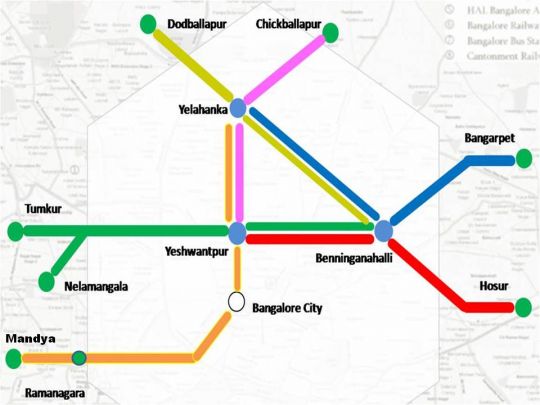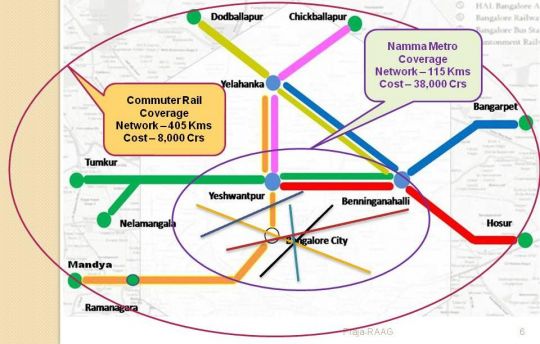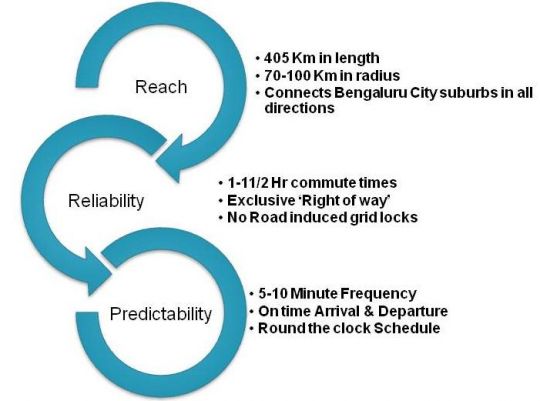Summary of June 2012 RITES draft report on CRS
In June 2012, RITES submitted a draft report on feasibility / go forward details on commuter rail service (CRS) for Bengaluru to DULT. Here is a summary and abstract of relevant portions of this report. The report is also available in full at this link.
Report Highlights
- Makes a strong case for CRS and says it is a must for Bengaluru’s growing needs
-
Recommends Connecting Bengaluru with:
- Mandya/Ramanagaram, Tumkur/Nelamangala, Doddaballapur, Chikballapur
- Whitefield, Anekal, Hosur, Malur, Bangarpet
-
Considering the 'Exclusive Right of Way' feature of rail transport,
- Points out that there will be no road induced grid locks, traffic jams, road congestion etc.
- Argues that it will enable fastest travel option covering 70-100 Kms in 1-11/2 hr.
- Ensures on time arrivals and departures.
- Predictable travel times
- Makes it execllent reliable daily commute options for citizens
- Concludes that on completion CRS will have capacity to carry 20 lakh commuters / day
- Recommends that trains should cross city centers and terminate beyond city centers – No termination at city edges as recommended/suggested in some govt quarters.
- With facts and figures makes unequivocal claim that CRS is possible with significant upgrades to IR infrastructure
- Estimates a cost of 8000 Crores over 7 Years for works spraed accross 3 Phases.
- Makes a claim that CRS can be operational in 2 Years with completion of Phase 1A costing 3200 Crores.
CRS Routes/Segments

Commuter Rail - 4 Times the Network @ 1/5th of the cost

Bengaluru CRS Features

RITES - CRS Cheapest Alternative!
Cheapest Alternative
Sec 3.2 - Potential in terms of Capacity
Maximum Peak throughput:
Rail - 60000 Passengers/Hr
Metro - 40000 passenger/Hr
BRT - 500 Passengers/Hr
Sec 3.4 - Potential in terms of Cheapest Alternative
- Metro costs 12000 Crores for 42.3 Km with carrying capacity of 1 Million (10 Lakhs) commuters per day.
- CRS with 8000 Cr investment will yield 405 Km of CRS network and would carry about 2.5 Million commuters per day.
- CRS could take the burden of 50% of greater Bangalore's total commuters population.
Sec 3.6 - Capacity Assesment Metro Vs CRS
- By its Width - Metro coach is 2.88 meters, CRS BG Coach is 3.66, i.e. it is 26% more.
- By its length - Metro train - 6 Coaches, CRS train - 16 coaches, i.e. CRS train is 2.67 times of a metro train.
Capacity of CRS train
1 CRS Train = 2.67 X 1.26 = 3.3 metro trains.
About a proposal to terminate CRS at City outskirts
Sec 4.5, Page 32, 2nd Para
"...Therefore, it is recommended not to terminate the commuter trains short of Bangalore. Terminals need to be the farthermost stations in the CRS i.e. Tumkur, Mandya, Bangarapet and Hosur etc. All other stations including major stations like Bangalore City, Yesvantpur etc. need to be passing through stations..."
RITES - CRS implementation in 3 Phases
Three Phases
RITES report has divided all the works that are needed for CRS into 3 Phases. The Phases are 1A, 1B and 2. Each of these have been identified with slew of works to be carried over, cost of works and the time frame to complete the works.
There is the 4th Phase that has been identified in the report. There are works earmarked for that phase. But there is no cost or time frame has been given citing the reasons of continuous improvements and too far in time to give a definite cost and time.
Phase-1A
Works
- SBC Terminal - Add 2 additional platforms
- SBC Terminal - Shift pit lines to Binny Mill Land
- Procure EMU Rakes - 15 Nos (Replace the MEMUs/DEMUs with EMU rakes)
- EMU Maintenance Shed at Yelahanka
- SBC Terminal - Entry/Exit from all directions
- 2 Single lines between SBC - BNC (cantonment)
- Automatic Signalling between BNC to WFD
- Electrification of Sections - YPR/BYPL/HSR, SBC/YPR/TK, YPR/YNK/CBP
- Platform modifications - Height raised to EMU height
- Passenger Amenities at BWT, MYA, TK, HSRA, DBY, CBP, YPR and YNK - Parking, Waiting Halls. Platforms, FOBs etc.
Invest Cost
- Rs. 3433 Crores
Time Frame
- 2 Years
Result - CRS with caryying capacity of 5 Lakh trips per day
Phase - 1B
Works
- Doubling of Lines on sections - WFD/BWT, YNK/DBU, YPR-BYPL, SDVL-NNGA
- Automatic Signalling on sections - WFD/BWT, YNK/DBU, YPR-BYPL, SDVL-NNGA
- Developing BYPL into Coaching Terminal - Build 5 Platforms, 10 Pitlines, 11 Stabling Lines
- Additional Rakes - 9 Nos.
Investment Cost
- Rs. 2363 Cores
Time Frame
- 2 Years
Result - CRS with enhance capacity of 10 Lakh daily trips.
Phase - 2
Works
- Remodel SBC Terminal - Final Phase
- 3 Flyovers in BYPL area
- 1 Flyover in YPR area
- Bypass line at YNK connecting DBU and CBP lines
- Developing new halt stations
- Additional EMU rakes - 15 Nos.
Investment Cost
- Rs. 2550 Crores
Time Frame
- 3 Years
Result - CRS with total carrying capacity of more than 25 lakh daily trips.
Phase - 3
Works - Extension of CRS reach and activities
- Extend CRS on Chikbanavar -Satyamangala new line which is under construction
- Restoration of BYPL-Vimanapura abandoned line and extend CRS on that line.
- Direct line to Enter from YNK to HEB without touching YPR.
- Introduce Longer EMUs
- Introduce Faster Services (Limited Halts)
- Quadrupling / Tripling of SBC-WFD, BYPL-HSRA, SBC-TK, SBC-MYS and other sections
- Elimination of All level crossings
- Skywalk at BYPL connecting BYPL train terminal to BYPL Metro Terminal
- 4th Coaching Terminal at Hejjala
- New Freight Terminals in TK, MYS and DBU sides
- Ring Rail around the city - One at 40 Km radius, second at 70 Km radius
- Construction of Air Link Rail
Note - No cost or time frame is given in the report.
RITES - Capacity Enhancement Strategies
Section 5 - Capacity Enhancement Strategies
Bangalore - SBC Terminal
- Shifting 4 Pit lines to Binny Mills land
- No terminal or shunting operations
- Universal dispatch/receiving facilities
- Platforms to be full length
- Trains to go in all directions (YPR to MYS and BYPL, MYS to YPR, BYPL, BYPL to MYS, YPR directions)
- Add 5 more platforms (Current 10), total 15.
This will increase the SBC 's current handling capacity from 60 to 150 pairs of trains
Yeswantpur Terminal
- 3 More Pit lines
This will increase YPR terminal capacity from 37 to 60 pairs of trains.
Baiyappanahalli Terminal
- 10 new pit lines
- 5 new stabling lines
- 6 R&D lines
- 5 platforms
This will allow BYPL to handle 70 pairs of trains from 0 pair it is handling now.
Yelahanka Terminal
- Develop this as 3rd coaching terminal
- Build EMU maintenance shed
- Build Terminal Facilities ( At present it is a pass through station)
Multi Terminal on MYS Section
- Adding 1 platform each Kengeri, Hejjala, Bidadi, Ramanagaram, Channapatna, Maddur and Mandya.
- Terminate one train at each of the above station
This will bring relief to SBC and enhances the commuter capacity.
Hejjala Terminal
- Develop this as 4th coaching terminal
- 6 new pit lines
Flyovers to avoid criss-cross movements at BYPL and YPR
- Bangalore - Hosur flyover
- Bangarpet - Yelahanka Flyover
- Bangarpet - Hebbal Flyover
- Yelahanka - Bangalore flyover
- at LOGH
Automatic Signaling
- Replace existing block signaling with Automatic signaling
- Will give a spacing of 2Km compare to existing 4-6 Kms.
Electrification and Doubling
- All sections at minimum be double lines
- All lines must be electrified
Level Crossings
- All level crossings to be replaced with ROB/RUB
Additional Halts
- CRS halts For every 1 Km within city core. 15-20 Km from SBC
- Every 2 Km beyond the city core
- Every 3-4 km in the sub-urbs
Rakes
- EMU rakes
- 100 sitting capacity compare to normal rakes of 80 capacity.